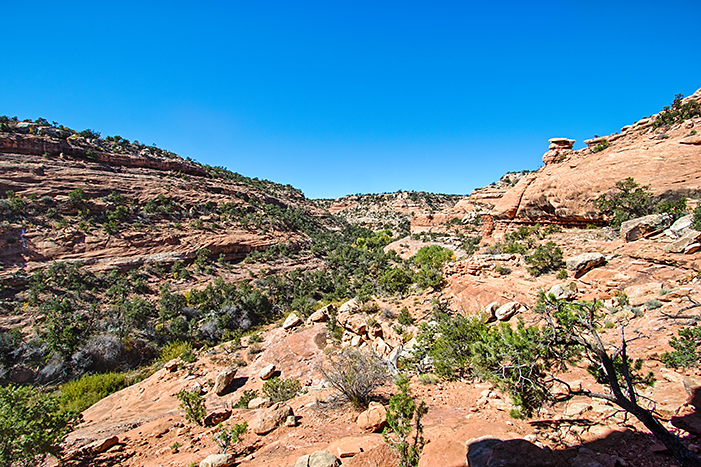Fallen Roof Ruins
 Fallen Roof Ruins is very similar
to House on Fire ruins. They are both on Cedar Mesa and are located in canyons with intermittent streams. They are both under alcoves on a ridge
above the wash. But the hike to House on Fire is more like a walk down a flat wash while getting to Fallen Roof required hiking down a side canyon
from the rim to reach the main wash. A flash flood or a series of flash floods seems to have eroded the side canyon considerably since were there last.
There were several challenging downclimbs that weren't there last time. Fallen Roof Ruins is much higher above the canyon floor than House on Fire Ruins
and requires a scramble along the sandstone ledges to reach the "porch" in front of the ruins. The ruins are also in a much tighter space and
the angles for photographing are much more limited. You have to be much more aware of where you're backing up or the next step would be in thin air. When we finished shooting, we returned to the flat "porch" area. Eight hundred years ago, parents probably sat in the same place and watched
their children playing in the canyon below. Maybe it was the children's voices we heard in the rustle of the cottonwood trees in the breeze.
Fallen Roof Ruins is very similar
to House on Fire ruins. They are both on Cedar Mesa and are located in canyons with intermittent streams. They are both under alcoves on a ridge
above the wash. But the hike to House on Fire is more like a walk down a flat wash while getting to Fallen Roof required hiking down a side canyon
from the rim to reach the main wash. A flash flood or a series of flash floods seems to have eroded the side canyon considerably since were there last.
There were several challenging downclimbs that weren't there last time. Fallen Roof Ruins is much higher above the canyon floor than House on Fire Ruins
and requires a scramble along the sandstone ledges to reach the "porch" in front of the ruins. The ruins are also in a much tighter space and
the angles for photographing are much more limited. You have to be much more aware of where you're backing up or the next step would be in thin air. When we finished shooting, we returned to the flat "porch" area. Eight hundred years ago, parents probably sat in the same place and watched
their children playing in the canyon below. Maybe it was the children's voices we heard in the rustle of the cottonwood trees in the breeze.
 |
 |
 |
| Fallen Roof Ruins | Fallen Roof Ruins | View from "Porch" of Fallen Roof Ruins |
As we hiked back out of the canyon, we met a group of five from Glenwood Springs, Colorado. They were obviously intrepid hikers and in much better shape than we are. They were very friendly, and we compared notes on places we've been. They warned us that if we're going to Colorado next fall, a key bridge that we need to cross to get to Aspen is being replaced in Glenwood Springs. They offered us a beer as a motivator to climb to the trailhead on the canyon rim. Sure enough, when we got back to the Explorer, they offered us that beer. They seemed to be having a lively discussion while eating lunch under the juniper trees. They must have packed up shortly after we left, because each of them passed us on the dirt road going back to the main highway. They had far less concern that it was a single-lane road with blind corners.
Since our visit to House on Fire and Fallen Roof Ruins, this area has become a national monument. President Obama set the area aside as a part of Bears Ears National Monument. A coalition of Native American tribes has been trying for decades to get this land set aside. It's too bad it took so long, but the multitude of groups that provided input made it very difficult to find a compromise that local Native Americans, environmentalists, off-roaders, and hunters could accept. Now, no group is totally happy but the area is protected. This area is incredibly rich with archeological sites, which would be threatened if the area were opened to oil extraction. Not only would the area be changed forever with all the access roads, but the vibrations from the drilling, explosives, injecting poisons into the rock strata, and heavy truck traffic would damage the structures of the ruins. It's still possible that Trump and the GOP will change the regulations and destroy this area, but it will be a little harder now that it's a national monument. However, Chaffetz and Bishop from Utah are working hard to get the protections removed, the land given to the state of Utah, and the area re-opened to sell to the highest bidder. All indications are that the next four years are going to be devastating for our public lands and a windfall for a few energy corporations.

